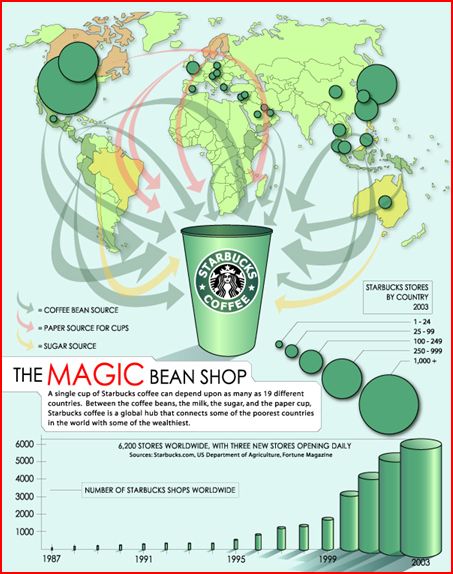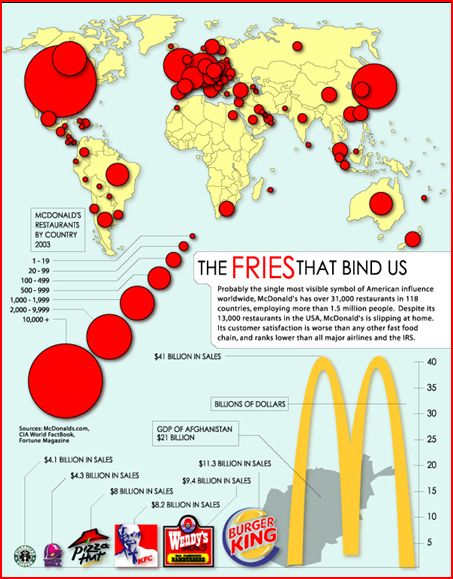Toban B. sent us a link to these two images illustrating the global spread of Starbucks and McDonalds (put together by Princeton):


UPDATE: Toban offered these great insights in the comment thread:
When I sent this in, I was looking at the images as indicators of who is and isn’t part of certain aspects of ‘globalization.’
While there has been increased homogenization, some people also have exaggerated the extent to which we all are part of One world (which some people call a “global village” — a term that I find downright ridiculous, to be frank.) I think that people talk like the world is all One because they are ignoring most of the world — i.e. the spots on the above maps that don’t have many coloured dots on them. Obviously the ‘North’ ‘Western’ areas also are very different in some respects (e.g. linguistically), but there’s more consistency in those areas of the world in terms of McDonaldization, digitization, and other features of the ‘North’ ‘Western’ ends of ‘globalization’ — that is, the sides of ‘globalization’ that people tend to highlight (whereas people don’t pay much attention to international waste trade dumping grounds, for instance).
If the world is all One, it is One in a way that entails different positions (e.g. as producers vs. consumers), and a lot of inequality (e.g. in terms of where the money is). If (for instance) Columbia is part of some sort of globalization, the place of Latin America is a lot different from France (for instance).
—————————
Lisa Wade is a professor of sociology at Occidental College. You can follow her on Twitter and Facebook.

Comments 24
Le — June 26, 2009
Yeah that's kinda scary. Conformity and uniformity!
T B — June 27, 2009
When I sent this in, I was looking at the images as indicators of who is and isn't part of certain aspects of 'globalization.'
While there has been increased homogenization, some people also have exaggerated the extent to which we all are part of One world (which some people call a "global village" -- a term that I find downright ridiculous, to be frank.) I think that people talk like the world is all One because they are ignoring most of the world -- i.e. the spots on the above maps that don't have many coloured dots on them. Obviously the 'North' 'Western' areas also are very different in some respects (e.g. linguistically), but there's more consistency in those areas of the world in terms of McDonaldization, digitization, and other features of the 'North' 'Western' ends of 'globalization' -- that is, the sides of 'globalization' that people tend to highlight (whereas people don't pay much attention to international waste trade dumping grounds, for instance).
If the world is all One, it is One in a way that entails different positions (e.g. as producers vs. consumers), and a lot of inequality (e.g. in terms of where the money is). If (for instance) Columbia is part of some sort of globalization, the place of Latin America is a lot different from France (for instance).
You could look at all of this through a 'world-systems' lense. I wouldn't do so myself (since I object to what I consider to be conservative and reductive features of that model) -- though I, personally, consider the 'world-systems' perspective OK if it is approached loosely, and if it isn't approached as some sort of a complete guide. (Wallerstein sometimes has presented himself as some sort of omniscient overseer of immense swathes of the world's past and future; that absurd grandiosity is part of what I happen to object to in 'world-systems' literature. Racism and patriarchy also don't receive nearly enough serious attention, and I could go on and on about what I see as shortcomings of standard 'world-systems' approaches.) The straightforwardness of the 'world-systems' model is somewhat of a merit though. For better or worse, I don't know of another perspective that offers such a straightforward overview of international disparities.
T B — June 27, 2009
By the way -
According to Wikipedia,
KFC, Pizza Hut, and Taco Bell all are part of this company -
http://en.wikipedia.org/wiki/Yum!_Brands#Brands
T B — June 27, 2009
You can cut and paste that link into your browser bar;
but I'll try again anyway -
http://en.wikipedia.org/wiki/Yum!_Brands#Brands
bitter pineapple — June 28, 2009
Can we please spell it Colombia?
K Lolz — June 30, 2009
I live in New Zealand aned we've had starbucks before 2003 .. they must be missing data
Elena — July 1, 2009
In Spain, most Starbucks, IIRC, are concentrated in Madrid and Barcelona, and they don't seem to be doing great -- the only one I ever visited, in the Passeig de Gràcia in Barcelona, closed some time ago.
They can't compete with our standard torrefacto coffee, it seems :D
Food Production in the U.S. » Sociological Images — March 10, 2010
[...] Related posts: feeding a city, Unilever encourages local eating, and the global distribution of Starbucks and McDonald’s, ownership of organic brands. var addthis_language = 'en'; 3 Comments Vajazzling [...]
hannah — April 10, 2010
hello, i think this is an interesting information. may i ask that how did you get the data of starbucks distribution?
Services: Starbucks | GEO 106 Human Geography — December 8, 2013
[…] http://thesocietypages.org/socimages/2009/06/26/the-global-distribution-of-starbucks-and-mcdonalds/ […]
ok — September 23, 2015
hi
spuds are us — September 23, 2015
potato head
AKW — October 29, 2018
Nice infographics, full of pieces of information.
Bill Clinton — September 21, 2020
Wow, this is deep.
Eric Scot — August 28, 2025
The starbucks nutritional information helps customers easily check the nutritional values of their favorite drinks and snacks. By entering your preferred coffee or food item, you can see calories, sugar, and protein details instantly. This tool makes it simple to make healthier choices while still enjoying your coffee moments.
smilikoa — November 11, 2025
Discover the full Whataburger menu packed with fresh, made-to-order burgers, fries, shakes, and more. Find your favorite meal and enjoy Texas-sized flavor in every bite. for more updates visit https://whataburgers.us/
Simon — November 17, 2025
There are many starbucks for USA but none of them are offering the Starbuck Nutrition calculator which thought I made own calculator.
Tonny Macy — November 17, 2025
There are many starbucks for USA but none of them are offering the starbucks nutrition calculator which thought I made own calculator.
Pandaexpres menu — November 26, 2025
Very interesting analysis it's impressive to see how global food chains spread and influence eating culture worldwide. With so many fast-food options available now, many people look for variety and convenience. For instance, when I want Asian-style fast food instead of usual burgers or coffee, I check the Panda Express Menu it’s a good example of how food choices diversify beyond traditional chains like Starbucks or McDonald’s. Thanks for sharing this global insight on food distribution!
Pandaexpres menu — November 26, 2025
Very interesting analysis it's impressive to see how global food chains spread and influence eating culture worldwide. With so many fast-food options available now, many people look for variety and convenience. For instance, when I want Asian-style fast food instead of usual burgers or coffee, I check the Panda Express Menu it’s a good example of how food choices diversify beyond traditional chains like Starbucks or McDonald’s. Thanks for sharing this global insight on food distribution!https://pandaexpressmenuu.us/